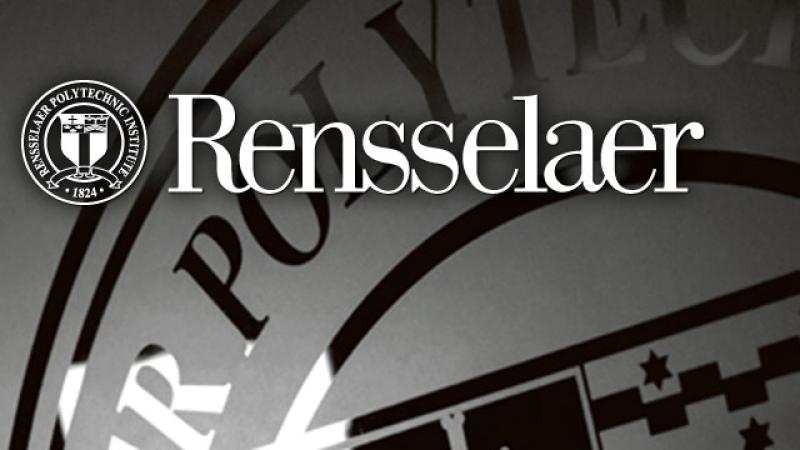January 6, 2012

Two members of the Rensselaer Polytechnic Institute faculty have been named fellows of the American Physical Society (APS). The APS is among the largest and most prestigious organizations in the world dedicated to the advancement of physics. James Napolitano, Rensselaer professor of physics, applied physics, and astronomy, and Vincent Meunier, the Gail and Jeffrey L. Kodosky ’70 Constellation Professor of Physics, Information Technology, and Entrepreneurship, have been elected as 2011 fellows for their exceptional contributions to the field of physics.
Meunier was recognized for his work in computational physics. He was specifically cited “for advancing the fields of nanoscience and nanotechnology through the application of innovative theory and advanced computation for the understanding of energy flow and storage mechanisms in nanostructured materials including carbons and metal oxides.”
Napolitano was recognized for his work in nuclear physics. He was specifically cited “for contributions to fundamental problems of nature through experiments in nuclear physics.”
“Fellowship to the APS represents an exceptional achievement for any physicist. I congratulate Drs. Napolitano and Meunier on this distinction,” said Laurie Leshin, dean of the School of Science at Rensselaer. “Both of these talented scientists exemplify the Rensselaer commitment to excellence in research and scientific discovery.
“Dr. Napolitano’s research is teaching us about some of most mysterious particles in the universe and opening up entirely new pathways of inquiry. He is also an exceptional teacher, developing innovative ways to educate a new generation of physicists.
“Dr. Meunier has brought exciting new expertise to Rensselaer in the study of materials at the atomic scale, teaching us how to build new nanomaterials that could revolutionize energy storage and electronics.”
Napolitano joined Rensselaer in 1992. His research centers on experimental particle and nuclear physics. His work extends to distributed computing as well as the development of better instructional laboratory technology and course work for students. His current work seeks to better understand a type of little-understood subatomic particle called the neutrino. This research takes him around the world to help create the massive reactors required to study neutrinos. This includes a current project in China called the Daya Bay Reactor Neutrino Experiment. Napolitano has been involved in the Daya Bay project since the beginning, working to design, install, and operate important technical components of the experiment reactor, which began gathering experimental data in August 2011.
He is also preparing for the next phase of neutrino experiments being planned in the Homestake Gold Mine in South Dakota. A better understanding of neutrinos could help unlock some of the physical secrets of the universe.
Prior to joining Rensselaer, Napolitano was an assistant professor of physics at the College of William & Mary, and a scientist at the Jefferson National Accelerator Faculty, a U.S Department of Energy laboratory dedicated to the study of the atom. Napolitano worked directly with the lab’s powerful particle accelerator, the Continuous Electron Beam Accelerator Faculty. Prior to that, he was a scientist at the Argonne National Laboratory in Illinois. He as an active teacher and mentor, developing new and improved courses in physics, quantum mechanics, the physics of design, and astronomy. He also revised two widely used physics textbooks, including Experiments in Modern Physics published by Academic Press and Modern Quantum Mechanics published by Addison Wesley. He has published more than 250 academic papers. He received bachelor’s and master’s degrees in physics from Rensselaer, and a doctorate in physics from Stanford University.
Meunier joined Rensselaer in 2010. His research uses computation to examine the atomic-level detail of materials. With high-throughput computing powers, such as those within the Rensselaer Computational Center for Nanotechnology Innovations (CCNI), Meunier works to optimize these nanomaterials, starting at the atomic level, to use as little energy as possible and target their functionality. This leads to fundamental advancements in the energy storage capabilities of new materials.
Meunier came to Rensselaer from the U.S. Department of Energy Oak Ridge National Laboratory, where he was a member of the senior research staff. Before his nearly nine years with Oak Ridge, he served as a postdoctoral research associate at North Carolina State University. He earned a bachelor’s degree in physics, a master’s degree in chemistry, and a doctoral degree in physics — all from the University of Namur in Belgium. He received the Early Career Award for the Oak Ridge National Laboratory in 2007, has published over a hundred papers, and holds two patents.
The APS is a nonprofit membership organization working to advance and diffuse the knowledge of physics through its research journals, scientific meetings, and education, outreach, advocacy, and international activities. APS represents 48,000 members, including physicists in academia, national laboratories, and industry in the United States and throughout the world. A very small percentage of its membership is elected as fellows each year.